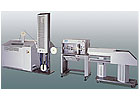
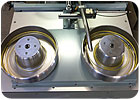
Dual-pan coilers allow the operator to grab a finished coil from the first pan, while another coil is being wound in the second pan. This improves productivity of the coiling operation. Photo courtesy Artos Engineering Co.
Payoffs, Dereelers and Prefeeders
As its name implies, a spool payoff is used with wire that is delivered on a spool rather than in a barrel.A spool pay-off is a stand used to support the spool. It can be motorized or non-motorized and uses a brake to prevent the over-rotation that results in wire spill-out.
The Mello Co. makes the 26-model Multi-Rack series of spool payoffs. These units feature stationary or wheeled steel frames that hold from one to 32 spools. Each spool can hold up to 60 pounds of wire.
Some models feature a rotating center pole with multiple racks on all four sides. This design allows users to easily store and use different wire sizes on one device. To prevent unwanted rotation, the user locks the pole in place.
Dereelers and prefeeders are positioned either right after the spool payoff or at the beginning of an automated wire processing line. In the latter situation, wire is stored inside the machine being used.
Dereelers and prefeeders feed wire from the spool into automatic cutting and stripping equipment. They also prevent tangling and eliminate delivery drag, which can create inconsistent wire lengths. However, they do it in slightly different ways.
“Prefeeders pull the wire, whereas dereelers push the wire into processing equipment,” says Andre Gilbraith, product manager for Komax Systems Inc.
DuPage Tying Solutions sells the ACE 680 prefeeder, which is designed for use with high-speed wire processors, says Bruce Eilenfeldt, president of DuPage Tying. The ACE 680 enables the processors to maintain a high production rate when marking wire. It also minimizes wire tangles at the barrel.
Komax makes one dereeler and several prefeeders, including the Model ads (advanced delivery system) 123. This heavy-duty machine handles reels up to 39.37 inches wide that weigh up to 1,320 pounds. It allows easy reel changes, offers quick thread-in and thread-out of the wire and requires no operator during operation.
Artos Engineering Co. also makes a dereeler, the 45712. Its storage pulleys provide a smooth and continuous unwinding of wire. This benchtop machine handles 8 to 30 AWG wire on 6- to 16-inch-diameter spools. Maximum allowable spool width is 11.5 inches.
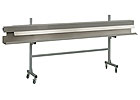
Wire stackers feature an eject shute, into which the wire is pushed, and a lower tray, into which the processed wire is axially stacked. Wire stackers tend to be used for stiff wire up to 10 feet long. Photo courtesy Schleuniger Inc.
Coilers
Coilers coil long wire (typically 10 feet or more) as it exits a processing machine, enabling operators to create wire bundles they can more easily stack or store. Some companies use coilers to process long wires when they have too little space to use a long conveyor system.A coiler features one or two pans that collect and coil the wire. For efficient wire processing, the coiler is connected to, and synchronized with, a cut and strip machine. After a wire is processed, it is deposited in the coiler pan and quickly wound into a nice, neat coil.
“Dual-pan coilers allow the operator to grab a finished coil from the first pan, while another coil is being wound in the second pan,” says Pete Doyan, vice president of product management for Schleuniger Inc. “This improves productivity of the coiling operation.”
Doyan suggests companies make sure the coiler they purchase meets their performance requirements. Specifically, the machine should be able to coil the diameter wire they use, and produce a coil at the diameter and weight they desire.
Schleuniger makes several coilers. The CableCoiler 1300 is a fully synchronized dual-pan unit that can handle wire with a maximum OD of 0.47 inch. An anti-slip surface on the inside of the pans helps control the coiling process. The CableCoiler 1300 can handle both small and large batches with quick changeover times due to an intuitive touch screen user interface.
Artos makes single- and dual-pan coilers. The CD-11 is a motorized, dual-pan coiler that can be fully integrated with the company’s CS-326 cutting and stripping machine.
The CD-11 handles wire up to 100 feet long and up to 0.625 inch wide. Collection bowls can be either 12 or 16 inches in diameter. The unit weighs 125 pounds.
Collectors and Stackers
Long wire collectors and wire stackers perform an important task-helping companies efficiently bundle long wires processed on automatic cutting and stripping equipments-but the machines do it in slightly different ways.
Stackers feature an eject shute, into which the wire is pushed, and a lower tray, into which the processed wire is axially stacked. Wire stackers tend to be used for stiff wire up to 10 feet long.
Collectors, in contrast, are designed to handle very long wire (more than 30 feet) and keep it straight after processing. They feature a motorized, variable-speed conveyor that pulls the processed wire from the cutting and stripping machine and moves it into a collection tray for bundling. Some collectors feature upper and lower trays so the user can collect two batches before bundling and or removal.
Although long-wire collectors operate independently of the wire processing machine, companies should synchronize the transport speed of the collector’s conveyor belt with the transport speed of the processing machine for best results.
The AL-Series of collectors from Artos features a specially designed brake and sweep mechanism that removes the wire from the belt and places it in a stationary tray, says John Olson, president and CEO of Artos. In addition, collected or bundled wire can be manually removed from the collection tray without risk of wire damage, with or without machine stoppage.
The AL-Series can collect 6 to 22 AWG wire up to 32 feet long. There are four models in the series with conveyor lengths of 5, 9, 16 and 32 feet, respectively.
The WireStacker 3150 from Schleuniger quickly and carefully collects and stacks all kinds of wire, including floppy wire. The integrated batch tray improves operator flexibility, allowing him to perform additional duties simultaneously to the production process.
The system is available in lengths of 8.2, 16.4, 24.6 and 32.8 feet. Schleuniger also offers collection-tray extensions of 6.56 or 13.12 feet. Installation takes less than 2 minutes and requires no tools.
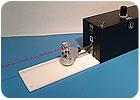
Twisters twist two or more wires around each other a set number of times at a set pitch length per inch. A clamping system holds the wire and a motorized spindle twists the wire. Photo courtesy The Mello Co.
Twisters
Harness assembly shops use twisters to make twisted wire pairs, which are two (or more) wires that have been twisted around each other a set number of times at a set pitch length per inch. A clamping system holds the wire and a motorized spindle twists the wire. Twisting machines come in benchtop, semiautomatic or fully automatic models.Twisted wire pairs prevent electromagnetic interference. Twisted wire pairs also are stiffer than two parallel wires bound together. Stiffer wire is easier to install in automobiles and other products requiring wire harnesses.
The Mello Co. offers three benchtop miniature twisters with foot-pedal activation. Wire is inserted by hand into an air collet at the front of the machine then secured by depressing the first-stage foot switch. Depressing the second-stage foot switch activates a timer-controlled motor to complete the twisting operation.
The MT and MT-II Mini-Twisters can twist pairs, trios and mini-harnesses containing 18 to 28 gauge wire. A third machine, the MHT Mini-Twister, can twist long wire and two wire pairs simultaneously. The MHT twists 18 gauge wire and has a fixed motor speed of 1,700 rpm.
Komax makes three benchtop and two semiautomatic models. The bt 288 is a semiautomatic machine capable of producing two wire pairs at a time, up to 600 pieces per hour. It also features touch screen controls and software that lets the operator input and save desired twisting parameters, including required cut length from the final length, pitch length, wire cross section and outside cable diameter.
The bt 288 handles wire cross sections from 2 by 0.08 millimeter to 2 by 4 millimeters squared. Wire pitch length can be adjusted from 8 to 50 millimeters.
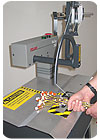
Processed wire that’s loose or coiled often needs to be tied together in a bundle so it can be moved and or stored. Photo courtesy DuPage Tying Solutions
Tyers
Processed wire that’s loose or coiled often needs to be tied together in a bundle so it can be moved and or stored. DuPage Tying sells several machines from Plas-Ties, Tach-It, Bedford Technology and Felins. All of the tyers sold by DuPage Tying can be integrated into automated systems or mounted directly on a bench or optional cart.The Felins 2000-6 tyer uses elastic string or cord to fasten bundles that are 0.25 inch to 6 inches in diameter, at a speed of 40 to 50 cycles per minute. It is activated by foot switch or a micro-switch at the table surface. In addition, the Felins 2000-6 tyer features an extended throat length that accommodates long bundles and lets the operator tie from either side.
HellermannTyton Corp. makes three tyers, says Joe Roberts, director of sales-tooling systems for the company. The largest is the ATS3080, which automatically ties wire bundles up to 3.14 inches in diameter with one trigger squeeze. Designed to be a waste-free system, the ATS3080 uses just enough strap material to secure the bundle. The strap is serrated on the outside to prevent wire damage.
Three jaw diameters are available-1.18, 1.96 and 3.14 inches-and they interchange easily. Other features include a low-weight, ergonomic handgrip for comfort and LED panel for easy tool operation and maintenance.
Tapers
Back in the late 1940s and 1950s, electrical tape was used to wrap wire harnesses. For the past several decades, harness assemblers have used specially designed taping equipment to bind, insulate and protect wire.
Two companies that make taping equipment are CAM Innovation and Start International.
CAM makes spiral and other types of taping machines, all of which are tabletop. Spiral machines apply tape across the length of a harness. The FT Machine uses a measuring wheel to determine how fast the wire is being pulled through the machine and automatically changes the speed of the taping head. Maximum feed rate is 62.5 feet per minute.
Manual and electric tape wrappers are available from Start. The TDW019 manual unit features heavy-duty aluminum construction, a safety blade guard and holes for mounting it to a workbench. It can wrap tape ranging from 0.375 to 0.75 inch wide around a wire bundle up to 2 inches in diameter. The TDW019 holds tape rolls up to 7 inches wide.
Taping machines apply several types of reinforced tape. 3M, for example, makes aluminum foil and glass cloth tapes that can be used to wrap wire harnesses. These tapes resist wearing and puncturing but do not hinder harness flexibility.
